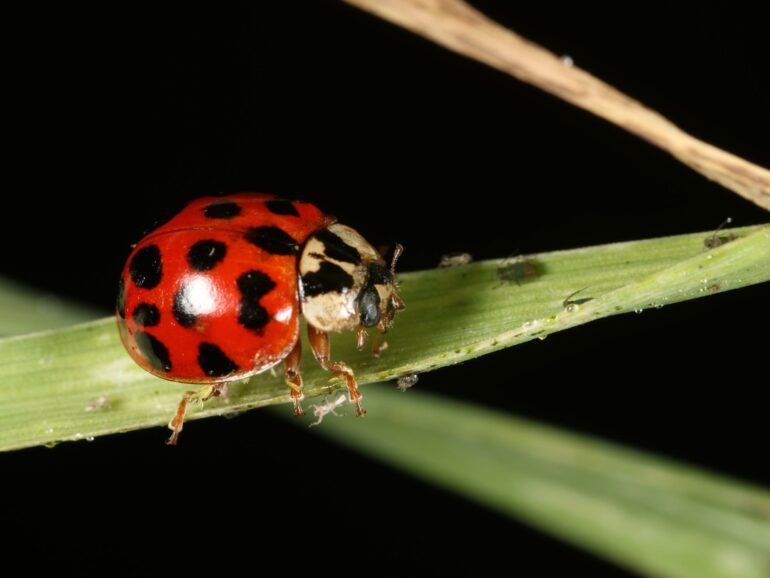The use of pesticides, while beneficial for global food security, wreaks havoc on natural ecosystems and human health. To address this issue, Penn State researchers have turned to an unlikely enforcer to protect crops: the ladybug. The team, led by Sara Hermann in the Penn State College of Agricultural Sciences, developed a novel pest management tool by leveraging the chemical ecology of predator-prey interactions between ladybugs and aphids.
They published their work in the journal Basic and Applied Ecology and recently filed a provisional patent application for the innovation.
While ladybugs are known to be ravenous consumers of aphids, small insects that eat nearly every kind of plant, Hermann has focused her research on the non-consumptive dynamics between these organisms. What piqued her interest is the aphid’s ability to detect the unique smells that ladybugs emit and process this smell as a cue to change behavioral traits that allow them to avoid being eaten.
“The major goal is to start to think outside the box,” said Hermann, the Tombros Early Career Professor and assistant professor of arthropod ecology and trophic interactions.
“We want to understand how the fear of being eaten influences behavior and physiology. We start with big ecological questions centered in agricultural systems to develop interventions. Using knowledge of basic ecological interactions that already exist, we can work with nature rather than against it.”
Hermann investigates aphid behavioral responses to ladybug “scents” and characterizes the chemical makeup of these scents. She conducts this research, which was featured in a recent PBS Terra video, in collaboration with the Huck Institutes of the Life Sciences’ Center for Chemical Ecology at Penn State.
Hermann and her team identified the main compounds constituting the ladybug scent in 2021 and found that the scent alone can induce certain behaviors in aphids. They apply the ladybug scent by diffusing it into the air around the plants, signaling trouble to aphids in the nearby vicinity.
In experiments, the researchers have found that aphids have a reduced preference for ladybug scented plants. In her most recent paper, in Basic and Applied Ecology, Hermann also found that the presence of ladybug odors also reduced the amount of time aphids ate and dropped their population numbers by 25%.
According to Hermann, the scent’s components can be commercially produced, which she hopes will make this intervention relatively accessible to develop and bring to market. She and co-author Jessica Kansman, assistant professor of plant sciences and plant pathology at Montana State University, recently received a patent for the scent, which may allow the product to be used as a pest deterrent by commercial operations and consumers in the public.
“Our work suggests that the presence of lady beetle odor cues alone may serve as a method to reduce aphid populations, at least short term, and could be a promising technique warranting further exploration,” Hermann said.
Similar chemical ecology processes that use pheromones to manipulate pest behavior were initially pioneered in pest management as “mating disruption.” Tom Baker, emeritus professor of entomology, helped lead these efforts, which have been applied widely in fruit crop systems with success, Hermann said. Mating disruption reduces successful mate finding of pest organisms using sex pheromones. Hermann’s findings, in contrast, use the “fear of predation” via predator odors to reduce pest attraction, development and feeding.
The scent intervention, developed for a widespread and destructive species of aphids, could provide a sustainable agriculture solution, according to the researchers. As opposed to other agricultural solutions that work by killing aphids, Hermann said that this treatment is not expected to result in resistance issues that are common with pesticide application.
Moving forward, Hermann said she intends to investigate the community-wide impact of applying the ladybug scent to agricultural fields. Additionally, her lab will investigate similar predator-prey dynamics in new predators and parasitoids, insects whose larvae parasitize other insects.
“Together with our colleagues at the Huck’s Center for Chemical Ecology, we’re harnessing the power of these and other natural chemicals and ecological dynamics,” Hermann said.
“In an era where environmental threats loom larger than ever, our commitment to these sustainable, nature-inspired practices is not just promising—it’s essential for the health and future of our planet.”
More information:
Jessica T. Kansman et al, Smelling danger: Lady beetle odors affect aphid population abundance and feeding, but not movement between plants, Basic and Applied Ecology (2023). DOI: 10.1016/j.baae.2023.05.004
Provided by
Pennsylvania State University
Citation:
Ladybug scents offer a more ecologically friendly way to protect crops (2024, February 23)



